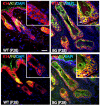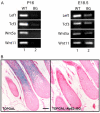Abnormal hair follicle development and altered cell fate of follicular keratinocytes in transgenic mice expressing DeltaNp63alpha
- PMID: 20335364
- PMCID: PMC2853845
- DOI: 10.1242/dev.045427
Abnormal hair follicle development and altered cell fate of follicular keratinocytes in transgenic mice expressing DeltaNp63alpha
Erratum in
- Development. 2010 May;137(10):1775
Abstract
The transcription factor p63 plays an essential role in epidermal morphogenesis. Animals lacking p63 fail to form many ectodermal organs, including the skin and hair follicles. Although the indispensable role of p63 in stratified epithelial skin development is well established, relatively little is known about this transcriptional regulator in directing hair follicle morphogenesis. Here, using specific antibodies, we have established the expression pattern of DeltaNp63 in hair follicle development and cycling. DeltaNp63 is expressed in the developing hair placode, whereas in mature hair its expression is restricted to the outer root sheath (ORS), matrix cells and to the stem cells of the hair follicle bulge. To investigate the role of DeltaNp63 in hair follicle morphogenesis and cycling, we have utilized a Tet-inducible mouse model system with targeted expression of this isoform to the ORS of the hair follicle. DeltaNp63 transgenic animals display dramatic defects in hair follicle development and cycling, eventually leading to severe hair loss. Strikingly, expression of DeltaNp63 leads to a switch in cell fate of hair follicle keratinocytes, causing them to adopt an interfollicular epidermal (IFE) cell identity. Moreover, DeltaNp63 transgenic animals exhibit a depleted hair follicle stem-cell niche, which further contributes to the overall cycling defects observed in the mutant animals. Finally, global transcriptome analysis of transgenic skin identified altered expression levels of crucial mediators of hair morphogenesis, including key members of the Wnt/beta-catenin signaling pathway, which, in part, account for these effects. Our data provide evidence supporting a role for DeltaNp63alpha in actively suppressing hair follicle differentiation and directing IFE cell lineage commitment.
Figures









Similar articles
-
Dynamic life of a skin keratinocyte: an intimate tryst with the master regulator p63.Indian J Exp Biol. 2011 Oct;49(10):721-31. Indian J Exp Biol. 2011. PMID: 22013738 Review.
-
ΔNp63 knockout mice reveal its indispensable role as a master regulator of epithelial development and differentiation.Development. 2012 Feb;139(4):772-82. doi: 10.1242/dev.071191. Development. 2012. PMID: 22274697 Free PMC article.
-
p63 induces key target genes required for epidermal morphogenesis.Proc Natl Acad Sci U S A. 2007 Feb 27;104(9):3255-60. doi: 10.1073/pnas.0611376104. Epub 2007 Feb 20. Proc Natl Acad Sci U S A. 2007. PMID: 17360634 Free PMC article.
-
Requirement of the forkhead gene Foxe1, a target of sonic hedgehog signaling, in hair follicle morphogenesis.Hum Mol Genet. 2004 Nov 1;13(21):2595-606. doi: 10.1093/hmg/ddh292. Epub 2004 Sep 14. Hum Mol Genet. 2004. PMID: 15367491
-
Notch signaling and the developing hair follicle.Adv Exp Med Biol. 2012;727:142-60. doi: 10.1007/978-1-4614-0899-4_11. Adv Exp Med Biol. 2012. PMID: 22399345 Review.
Cited by
-
Interaction between the TP63 and SHH pathways is an important determinant of epidermal homeostasis.Cell Death Differ. 2013 Aug;20(8):1080-8. doi: 10.1038/cdd.2013.41. Epub 2013 May 17. Cell Death Differ. 2013. PMID: 23686138 Free PMC article.
-
p53/p63/p73 in the epidermis in health and disease.Cold Spring Harb Perspect Med. 2014 Aug 1;4(8):a015248. doi: 10.1101/cshperspect.a015248. Cold Spring Harb Perspect Med. 2014. PMID: 25085956 Free PMC article. Review.
-
Evolutionary re-wiring of p63 and the epigenomic regulatory landscape in keratinocytes and its potential implications on species-specific gene expression and phenotypes.Nucleic Acids Res. 2017 Aug 21;45(14):8208-8224. doi: 10.1093/nar/gkx416. Nucleic Acids Res. 2017. PMID: 28505376 Free PMC article.
-
Overview of chromatin regulatory processes during surface ectodermal development and homeostasis.Dev Biol. 2024 Nov;515:30-45. doi: 10.1016/j.ydbio.2024.07.001. Epub 2024 Jul 4. Dev Biol. 2024. PMID: 38971398 Review.
-
TNF-α promotes c-REL/ΔNp63α interaction and TAp73 dissociation from key genes that mediate growth arrest and apoptosis in head and neck cancer.Cancer Res. 2011 Nov 1;71(21):6867-77. doi: 10.1158/0008-5472.CAN-11-2460. Epub 2011 Sep 20. Cancer Res. 2011. PMID: 21933882 Free PMC article.
References
-
- Andl T., Reddy S. T., Gaddapara T., Millar S. E. (2002). WNT signals are required for the initiation of hair follicle development. Dev. Cell 2, 643-653 - PubMed
-
- Barbieri C. E., Pietenpol J. A. (2006). p63 and epithelial biology. Exp. Cell Res. 312, 695-706 - PubMed
-
- Blanpain C., Fuchs E. (2007). p63: revving up epithelial stem-cell potential. Nat. Cell Biol. 9, 731-733 - PubMed
-
- Callahan C. A., Oro A. E. (2001). Monstrous attempts at adnexogenesis: regulating hair follicle progenitors through Sonic hedgehog signaling. Curr. Opin. Genet. Dev. 11, 541-546 - PubMed
-
- Candi E., Rufini A., Terrinoni A., Dinsdale D., Ranalli M., Paradisi A., De Laurenzi V., Spagnoli L. G., Catani M. V., Ramadan S., et al. (2006). Differential roles of p63 isoforms in epidermal development: selective genetic complementation in p63 null mice. Cell Death Differ. 13, 1037-1047 - PubMed
Publication types
MeSH terms
Substances
Grants and funding
LinkOut - more resources
Full Text Sources
Other Literature Sources
Molecular Biology Databases

